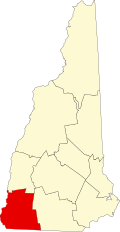Stone-Darracott House | |
 | |
| Location | Old Marlborough Rd., Dublin, New Hampshire |
|---|---|
| Coordinates | 42°53′34″N72°8′54″W / 42.89278°N 72.14833°W |
| Area | 0.6 acres (0.24 ha) |
| Built | 1792 |
| Built by | Stone, John |
| Architectural style | Colonial |
| MPS | Dublin MRA |
| NRHP reference No. | 83004077 [1] |
| Added to NRHP | December 15, 1983 |
The Stone-Darracott House is a historic house on Old Marlborough Road in Dublin, New Hampshire. It was built in 1792 by John Stone, an early settler of Dublin for whom nearby Stone Pond is named. The house was also made part of a "gentleman's farm" by Mrs. Alberta Houghton (of the Houghton Mifflin publishing family) in the early 20th century, along with the adjacent Stone Farm. [2] The house was listed on the National Register of Historic Places in 1983. [1]


